Innovation Management and Process
Feb 24, 2024
By Ari Manor , CEO at ZOOZ

This is one in a series of articles that provide detailed and updated information about Innovation.In this specific article, which focuses on Innovation Management and Innovation Process, you can read about:
- Innovation Management
- New Product Development
- Problem Solving
- Strategic Innovation
- Organizational Innovation
- Innovation Questions
- Systematic Innovation
- Systematic Innovation™ Workshops
- Idea Generation
- Idea Bank
- Idea Screening
- Concept Development and Prototyping
- Commercialization
- Innovation Research
- Innovation to Implementation
- Innovation Alliance
- Innovation Automation
- Open Innovation
For additional articles about Innovation, see the Topic Menu.

Innovation Management
Innovation management combines various strategies, processes, and tools to encourage and streamline the creation of new ideas, products, services or technologies within an organization. It's about harnessing the creative potential of employees, aligning innovation efforts with strategic business goals, and bringing novel solutions to market effectively.
Here’s a closer look at the key components of innovation management:
- Strategic Alignment: Innovation should be closely aligned with the organization's strategic objectives. This ensures that innovation efforts contribute directly to business growth, competitive advantage, and customer satisfaction.
- Culture and Leadership: A culture that fosters innovation is essential. This includes leadership support for innovation initiatives, a tolerance for risk and failure, and an environment that encourages creativity and experimentation.
- Processes and Frameworks: Effective innovation management requires structured processes and frameworks to guide the innovation journey from ideation to implementation. This includes clear stages for idea generation, evaluation, development, and commercialization, along with metrics to measure success.
- Collaboration and Diversity: Innovation thrives on diverse perspectives and collaboration across departments, disciplines, and even organizational boundaries. Encouraging cross-functional teams and leveraging external partnerships can lead to more creative solutions.
- Resource Allocation: Dedicated resources, including time, budget, and personnel, are crucial for nurturing and developing innovative ideas. Organizations must be willing to invest in innovation, even when outcomes are uncertain.
- Technology and Tools: Leveraging the right technology and tools can enhance innovation management by facilitating collaboration, streamlining processes, and providing insights into market trends and customer needs.
- Continuous Learning and Adaptation: The innovation landscape is constantly evolving. Organizations must be committed to continuous learning, staying abreast of industry trends, and being willing to pivot based on new information and market feedback.
Benefits of Effective Innovation Management
- Competitive Advantage: By continuously introducing novel products or services, organizations can differentiate themselves in the market.
- Increased Efficiency: Streamlining the innovation process can lead to faster time-to-market and improved ROI on innovation investments.
- Enhanced Creativity: A structured approach to innovation management can stimulate creativity by providing clear goals, resources, and support for idea generation.
- Customer Satisfaction: Aligning innovation efforts with customer needs ensures that new products or services meet and exceed customer expectations, leading to higher satisfaction and loyalty
Challenges in Innovation Management
- Balancing Creativity and Structure: Finding the right balance between creative freedom and the necessary structure can be challenging but is essential for productive innovation.
- Risk Management: Innovation involves risk, and managing this risk without stifling creativity is a key challenge for innovation managers.
- Measuring Success: Defining and measuring the success of innovation initiatives can be complex, requiring both quantitative and qualitative metrics.
How to Overcome These Challenges
- Balancing Creativity and Structure: interestingly enough, constraints enhance creativity by forcing our brains to think more deeply and differently. Therefore, we intentionally use structured thinking tools (such as SIT, SCAMPER, etc.) to increase creativity since absolute freedom (e.g., in "Blue skies" and brainstorming sessions) often reduces creativity.
- Risk Management: Our Systematic Innovation™ methodology was developed specifically to improve the success rate and reduce innovation risk. Systematic Innovation™ combines tools, methods, and principles that reduce risk at every stage of the innovation process. For example, in new product development (NPD) processes, we apply:
- Inventive Thinking tools that enable the prediction of 80% or more of all future inventions for a given product or service line. Achieving broader coverage of all possible inventions increases the chances to command the future.
- Rigorous internal screening of ideas followed by external screening via concept testing, which increases the success rate of the chosen and launched inventions. In fact, concept testing, if done properly and calibrated over time, enables the quantitative (!) prediction of how successful a new product or service will be.
- Every step in the Idea Funnels we create costs significantly more than the previous step. This saves time and money, and allows spending more on only a few great ideas, thus increasing the ROI of the innovation process. For example:
- In the idea generation phase, 50 or more ideas can be created in one workshop day.
- In the internal screening phase, we screen and discuss about 10-15 ideas per day.
- In the external screening phase, every concept tested requires one day.
- In commercializing, launching, and marketing a new invention, costs rise 10-100 fold.
- Measuring Success: For New Product Development (NPD) processes, we use one simple measurement to measure innovation success – the percentage of total revenues derived from new products and services (launched up to 1-3 years ago, depending on the industry).
- If, for example, the goal for this KPI is set to 25%, the innovation team has to focus on consistently innovating and growing, as they are required to bring successful new products (or services) time and again to rise to the challenge.
In conclusion, innovation management is a multifaceted discipline that requires strategic alignment, cultural support, structured processes, and continuous adaptation. By effectively managing innovation, organizations can foster a sustainable competitive edge, drive growth, and respond proactively to changing market dynamics and customer needs.

New Product Development
New Product Development (NPD) is a critical process within the realm of innovation, involving the conception, design, and launch of a new product or service. It's a multifaceted journey that transforms an idea into a marketable offering, addressing customer needs or opening new markets. NPD is essential for companies looking to stay competitive, adapt to changing consumer preferences, and capitalize on new opportunities.
Here's an in-depth look at the NPD process, its importance, and key strategies for success.
Stages of New Product Development (NPD)
- Idea Generation: This initial stage involves think tanks for gathering innovative ideas that could be turned into viable products. Sources of ideas include market research, customer feedback, competitor analysis, and internal brainstorming sessions (or better yet – using structured thinking tools instead of brainstorming).
- Internal Idea Screening: Not all ideas generated are worth pursuing. This stage filters out the feasible from the infeasible, focusing on potential market demand, alignment with business strategy, and available resources.
- Concept Development and Testing: Selected ideas are developed into detailed product concepts. These concepts are then tested with target customers to gauge interest and refine the product proposition.
- Warning: skipping this stage can prove VERY risky, primarily due to marketing myopia. Do not launch products before listening to the voice of the client.
- Business Analysis: This involves evaluating the commercial viability of the product concept, including cost analysis, sales forecasts, and profitability projections.
- Product Development: Once a concept is approved, it moves into development. This phase includes designing, prototyping, and testing the product, ensuring it meets quality standards and customer expectations.
- Market Testing: Before a full-scale launch, the product may be introduced to a limited market to test its performance and gather feedback, allowing for final adjustments.
- Commercialization: The final stage involves launching the product to the market, including production ramp-up, marketing strategy execution, and sales channel development.
Importance of New Product Development
- Sustained Competitive Advantage: Regularly introducing new products helps companies stay ahead of competitors and respond to market changes.
- Customer Retention and Attraction: New products cater to evolving customer needs, retaining existing customers and attracting new ones.
- Revenue Growth: New products open up additional revenue streams, contributing to business growth and profitability.
Principles for Successful New Product Development (NPD)
- Customer-Centric Approach: Successful NPD starts with understanding customer needs and preferences. Engaging with customers throughout the development process ensures the final product meets their expectations.
- Cross-Functional Collaboration: NPD requires the involvement of various departments, including R&D, marketing, finance, and operations. Effective collaboration across these functions is crucial for a smooth development process.
- Agile Methodology: Adopting an agile approach to NPD allows for flexibility, rapid iteration, and adaptation based on feedback, reducing time to market.
- Risk Management: Identifying and managing risks early in the development process can prevent costly setbacks and ensure project success.
- Leveraging Technology: Utilizing the latest technologies and tools can enhance product design, streamline development processes, and improve market analysis.
In conclusion, New Product Development is a cornerstone of innovation, driving business growth and adaptation in a fast-paced market. By following a structured NPD process and embracing customer-centric, collaborative, and agile approaches, companies can successfully bring new and innovative products to market, delighting customers and achieving competitive advantage.

Problem Solving
Problem-solving in the context of innovation is a systematic process aimed at identifying solutions to complex challenges within an organization or in the market. It involves understanding (and accurately defining) the problem, generating solutions, evaluating alternatives, and implementing the most viable option. Effective problem-solving is crucial for innovation as it enables the introduction of new technologies, and drives the development of new products, services, and processes that can meet emerging needs or address existing gaps.
Here’s a deeper look into the problem-solving process and its significance in fostering innovation.
Stages of the Problem-Solving Process
- Problem Identification: The first step is to clearly define the problem. This involves gathering information, understanding the context, and pinpointing the exact issue that needs to be addressed. Defining the problem accurately is already halfway to finding the solution.
- Problem Analysis: Once the problem is identified, the next step is to analyze it comprehensively. This includes understanding its root causes, the stakeholders involved, and the impact of the problem on the organization or customers.
- Idea Generation: With a clear understanding of the problem, the focus shifts to generating potential solutions. Techniques like Inventive Thinking, TRIZ, or SCAMPER can be employed to encourage creative thinking and ideation.
- Solution Evaluation and Selection: Generated ideas are then evaluated based on criteria such as feasibility, impact, and resource requirements. This stage helps narrow down the options to the most viable solution.
- Implementation: The chosen solution is developed and implemented. This may involve prototyping, testing, and gathering feedback to refine the solution further.
- Monitoring and Learning: After implementation, it’s important to monitor the outcomes, measure the effectiveness of the solution, and learn from the process. This feedback loop can inform future problem-solving efforts.
Importance of Problem-Solving in Innovation
- Drives Improvement: Effective problem-solving leads to improvements in products, services, and internal processes, enhancing efficiency and customer satisfaction.
- Encourages Creativity: The process of solving complex problems encourages creative thinking, pushing teams to think outside the box and explore novel solutions.
- Facilitates Adaptation: In today’s fast-paced environment, the ability to solve problems quickly and effectively enables organizations to adapt to changes and remain competitive.
- Builds Resilience: Developing strong problem-solving capabilities helps organizations navigate challenges, making them more resilient in the face of adversity.
Strategies for Enhancing Problem-Solving for Innovation
- Foster a Culture of Openness: Create an environment where every team member feels comfortable sharing ideas and challenges. An open culture encourages collaboration and collective problem-solving.
- Develop Diverse Teams: Diverse teams bring a range of perspectives and expertise to the problem-solving process, leading to more innovative solutions.
- Employ Structured Methodologies: Utilize structured problem-solving methodologies like TRIZ and Design Thinking, which focuses on understanding user needs and encourages iterative testing and refinement.
- Leverage Technology: Use technology and data analytics to gather insights, simulate scenarios, and evaluate the potential impact of different solutions.
- Promote Continuous Learning: Encourage teams to learn from each problem-solving experience, capturing lessons learned and best practices for future reference.
In conclusion, problem-solving is an integral part of the innovation process, enabling organizations to address challenges creatively and effectively. By adopting a structured approach and fostering a culture that supports collaboration and continuous learning, companies can leverage problem-solving to drive innovation and achieve sustainable growth.
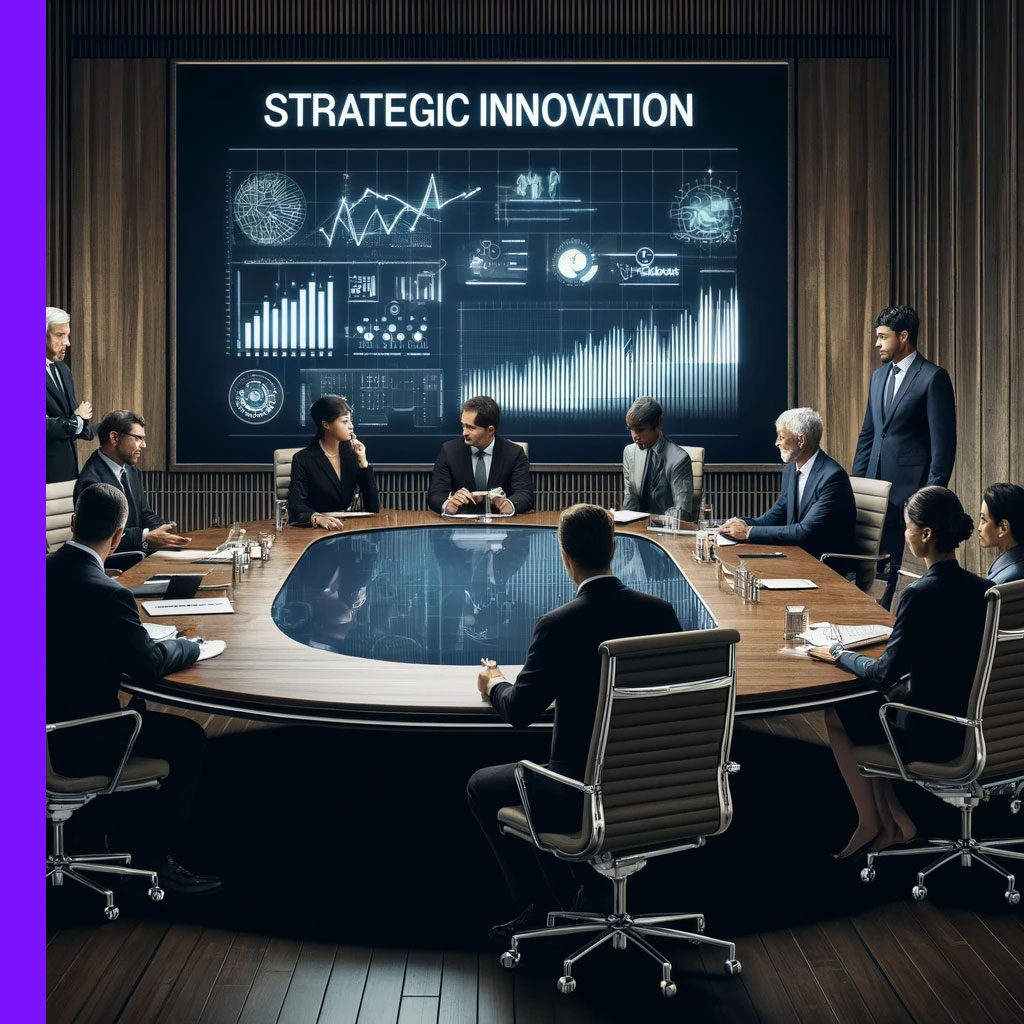
Strategic Innovation
Strategic innovation refers to the process of reinventing or significantly altering the business strategy, model, or practices of an organization to create competitive advantage, unlock new growth opportunities, and respond to changing market dynamics. It goes beyond product or service innovation by fundamentally changing how a business operates, delivers value to its customers, and positions itself in the marketplace. Strategic innovation can involve entering new markets, redefining product categories, changing the value proposition, or adopting novel business models.
Key Aspects of Strategic Innovation
- Redefining the Business Model: This could involve changing how revenue is generated, how products are delivered to customers, or how production is organized. For example, transitioning from a product-based to a service-based model.
- Exploring New Markets: Identifying and entering new markets, either geographically or demographically, can open up new revenue streams and diversify business risks.
- Revamping Value Propositions: Altering the value proposition to meet unmet customer needs or to appeal to a broader customer base can rejuvenate a company’s offerings and brand.
- Leveraging Technology: Adopting emerging technologies to transform business processes, customer experiences, or product offerings can lead to significant competitive advantages.
- Reconfiguring Supply Chains: Innovating in the supply chain can reduce costs, improve efficiency, and enhance flexibility, allowing companies to respond more quickly to market changes.
Importance of Strategic Innovation
- Sustainability and Growth: In a rapidly changing business environment, strategic innovation ensures long-term sustainability and growth by continually adapting to market trends and customer needs.
- Competitive Advantage: By differentiating business models and strategies, organizations can create a unique competitive advantage that is difficult for competitors to replicate.
- Resilience: Strategic innovation enhances an organization's resilience to external shocks by diversifying its revenue streams and reducing dependence on traditional markets or products.
Strategies for Implementing Strategic Innovation
- Customer Insight: Deep understanding of current and potential customers can reveal opportunities for strategic innovation. Continuous engagement and feedback mechanisms are crucial.
- Cross-Industry Inspiration: Looking beyond one’s industry for inspiration (and benchmarking) can uncover innovative business models or strategies that can be adapted to your context.
- Experimentation and Prototyping: Testing new business models or strategies on a small scale before full implementation can help refine the approach and reduce risks.
- Organizational Agility: Cultivating a culture and structure that supports agility, flexibility, and rapid decision-making enables organizations to innovate strategically and respond swiftly to opportunities.
- Strategic Partnerships: Collaborating with partners, whether through alliances, joint ventures, or acquisitions, can provide new capabilities, markets, or technologies to support strategic innovation.
- Change management: Effective change management strategies are essential to overcome resistance and align stakeholders, ensuring the smooth adoption of innovative practices.
Challenges in Strategic Innovation
- Cultural Resistance: Organizational culture and entrenched interests can resist changes to established business models or strategies.
- Resource Allocation: Strategic innovation often requires significant investment in new capabilities, technologies, or markets, which can strain existing resources.
- Market Uncertainty: Venturing into new business models or markets involves uncertainty and risk, requiring robust risk management and contingency planning.
How to Overcome these Challenges
- Addressing Cultural Resistance
- Leadership Endorsement: Secure strong support from leadership to champion innovation initiatives and communicate their importance throughout the organization.
- Inclusive Innovation: Engage employees across all levels in the innovation process to foster a sense of ownership and minimize resistance.
- Success Stories: Prioritize ideas that you can execute quickly and easily. Then - share examples of successful innovations, internally and externally, to build confidence and demonstrate the value of embracing change.
- Change management: Follow the “Leading Change” methodology by John Kotter, the top global expert in change management. Apply the recommended tactics to every step of the change process:
- Create a sense of urgency
- Build a guiding coalition
- Form a strategic vision
- Enlist a volunteer army
- Enable action by removing barriers
- Generate short-term wins
- Sustain acceleration
- Institute change
- Managing Resource Allocation
- Prioritization: Clearly prioritize innovation projects based on strategic alignment and potential impact to ensure efficient allocation of resources.
- Flexible Funding Models: Adopt flexible funding approaches, such as innovation funds or venture models, to support high-potential projects without straining core budgets.
- Leverage Partnerships: Form strategic partnerships to access new capabilities, technologies, and markets, distributing the investment and risk.
- Navigating Market Uncertainty
- Market Research and Insights: Invest in thorough market research to understand new markets or business models, reducing uncertainty through informed decision-making.
- Pilot Programs: Implement pilot programs or prototypes to test new ideas in a controlled environment, allowing for adjustments before full-scale rollouts.
- Agile Methodologies: Adopt agile methodologies that allow for quick iteration and adaptation based on real-world feedback and changing market conditions.
In conclusion, strategic innovation is essential for organizations seeking to maintain relevance and a competitive edge in the face of changing market conditions and emerging opportunities. By fundamentally rethinking and reshaping their strategies, business models, and operations, companies can unlock new growth paths and build a foundation for long-term success.

Organizational Innovation
Organizational innovation refers to the implementation of new internal processes, practices, structures, or methodologies within an organization that significantly improve its performance, efficiency, or outcomes. Unlike product or service innovation, which is externally focused, organizational innovation targets the internal mechanisms of an organization, aiming to enhance its operations and create a culture that fosters continuous improvement and adaptability. This type of innovation can encompass everything from adopting new technologies to streamline operations, to overhauling the company culture to encourage greater creativity and employee engagement.
Key Components of Organizational Innovation
- Process Innovation: This involves the introduction of new or significantly improved production or delivery methods. It can include the adoption of new technologies, automation, or more efficient workflows that reduce costs and improve quality.
- Structural Innovation: Changes in the organizational structure to better support the company’s strategy and innovation goals. This might involve creating new departments focused on innovation, adopting flat organizational structures to improve communication, or implementing cross-functional teams to enhance collaboration.
- Culture and Leadership Innovation: Cultivating a culture that embraces change, values creativity, and encourages risk-taking. Leadership innovation involves adopting new leadership styles or frameworks that empower employees, foster transparency, and support the free flow of ideas.
- Business Model Innovation: Although often considered a strategic innovation, changing the business model from within also falls under organizational innovation when it significantly alters how the organization operates internally and creates value.
Importance of Organizational Innovation
- Enhanced Competitiveness: By improving internal processes and efficiency, organizations can reduce costs, improve quality, and speed up delivery, enhancing their competitiveness in the market.
- Employee Satisfaction and Retention: A culture that values innovation and employee input can lead to higher job satisfaction, better performance, and lower turnover rates.
- Adaptability: Organizations that continuously innovate at the organizational level are better equipped to adapt to changes in the market, technology, and customer preferences.
Principles for Fostering Organizational Innovation
- Encourage Open Communication: Create channels for open communication across all levels of the organization. Encouraging feedback and ideas from employees can uncover opportunities for innovation.
- Invest in Training and Development: Equip employees with the skills and knowledge they need to contribute to innovation. This includes training in creative thinking, problem-solving, and the use of new technologies.
- Reward and Recognize Innovation: Establish systems to reward and recognize employees who contribute innovative ideas or improvements. This can motivate others to contribute as well.
- Implement Flexible Work Practices: Adopting flexible work arrangements can improve employee satisfaction and attract talent. Flexibility can also foster a more creative and innovative work environment.
- Leverage Technology: Stay abreast of technological advancements that can streamline operations, improve productivity, and facilitate innovation. Embrace digital transformation of your organization.
Challenges in Implementing Organizational Innovation
- Resistance to Change: Employees and managers may resist changes to established processes and structures. Overcoming this resistance requires clear communication of the benefits and support during the transition.
- Resource Allocation: Innovation initiatives often require upfront investment in time, money, and resources without immediate returns. Balancing these investments with ongoing operational needs is crucial.
- Maintaining Momentum: Initiating organizational innovation can be challenging, but maintaining momentum and continuously fostering an innovative environment can be even more difficult.
In conclusion, organizational innovation is vital for companies looking to improve their internal operations, adapt to the rapidly changing business environment, and maintain a competitive edge. By focusing on process, structural, cultural, and business model innovations, organizations can enhance their efficiency, agility, and employee engagement, laying the foundation for sustained success.

Innovation Questions
Innovation questions are pivotal in sparking the curiosity and critical thinking necessary to drive the innovation process forward. These questions challenge the status quo, uncover hidden assumptions, and open up new avenues for exploration and development. They are a fundamental tool for individuals and organizations aiming to innovate, providing a structured approach to identifying problems, opportunities, and potential solutions.
Here’s how innovation questions can be effectively utilized and some examples to illustrate their power.
Utilizing Innovation Questions
- Identifying Opportunities: Asking the right questions helps identify gaps in the market, unmet customer needs, or areas within the organization that could benefit from innovation. It’s about exploring “What if?” and “Why not?”.
- Challenging Assumptions: Many innovations start by questioning the assumptions underlying current practices, products, or services. “Why do we do it this way?” can lead to insights that challenge conventional wisdom.
- Encouraging Creativity: Open-ended, thought-provoking questions encourage creative thinking and brainstorming, leading to novel ideas and solutions. “How might we…?” questions are particularly effective.
- Focusing Efforts: Innovation questions can also help focus efforts on specific areas or problems. “Where is the biggest opportunity for improvement?” helps prioritize innovation activities.
- Facilitating Collaboration: Sharing and discussing innovation questions within teams can facilitate collaboration, bringing together diverse perspectives and expertise to tackle complex challenges.
Examples of Powerful Innovation Questions:
- What if we could eliminate the biggest pain point for our customers?
- This question encourages looking at the customer experience from a new perspective, focusing on removing obstacles or frustrations.
- This question encourages looking at the customer experience from a new perspective, focusing on removing obstacles or frustrations.
- Why do we adhere to this particular business model, and what alternatives exist?
- Challenging the current business model can uncover new ways of delivering value or generating revenue.
- Challenging the current business model can uncover new ways of delivering value or generating revenue.
- How might we leverage emerging technologies to enhance our product/service?
- This prompts exploration of how new technologies could be applied to existing offerings to create competitive advantage.
- This prompts exploration of how new technologies could be applied to existing offerings to create competitive advantage.
- Where are the untapped markets or demographics for our products/services?
- Identifying new markets can lead to significant growth opportunities.
- Identifying new markets can lead to significant growth opportunities.
- What would our product/service look like if it were designed for sustainability from the ground up?
- This question encourages a focus on sustainability, which is increasingly important to consumers and can lead to innovative, eco-friendly solutions.
- This question encourages a focus on sustainability, which is increasingly important to consumers and can lead to innovative, eco-friendly solutions.
- How can we transform our biggest challenge into our biggest opportunity?
- This reframes challenges as opportunities for innovation, encouraging a positive, proactive approach to problem-solving.
- This reframes challenges as opportunities for innovation, encouraging a positive, proactive approach to problem-solving.
- What processes within our organization are ripe for disruption, and how can we reimagine them?
- Looking internally for innovation opportunities can lead to significant improvements in efficiency and effectiveness.
- Looking internally for innovation opportunities can lead to significant improvements in efficiency and effectiveness.
Implementing Innovation Questions in Your Organization
- Cultivate a Questioning Culture: Encourage employees at all levels to ask questions and challenge the status quo. Make it safe to express curiosity and skepticism.
- Facilitate Idea Generation Sessions: Regularly hold ideation sessions focused on exploring innovation questions. Use methods like SIT, Design Thinking and Blue Ocean Strategy to structure such sessions.
- Leverage Diverse Perspectives: Include people from different departments, backgrounds, and levels of the organization in innovation discussions to ensure a range of viewpoints.
- Act on the Answers: It’s not enough to ask good questions; organizations must also be prepared to act on the insights and ideas that emerge.
In conclusion, innovation questions are a powerful tool for driving the innovation process. By systematically questioning existing conditions, assumptions, and practices, organizations can uncover new opportunities for innovation, challenge conventional wisdom, and foster a culture of continuous improvement and creativity.
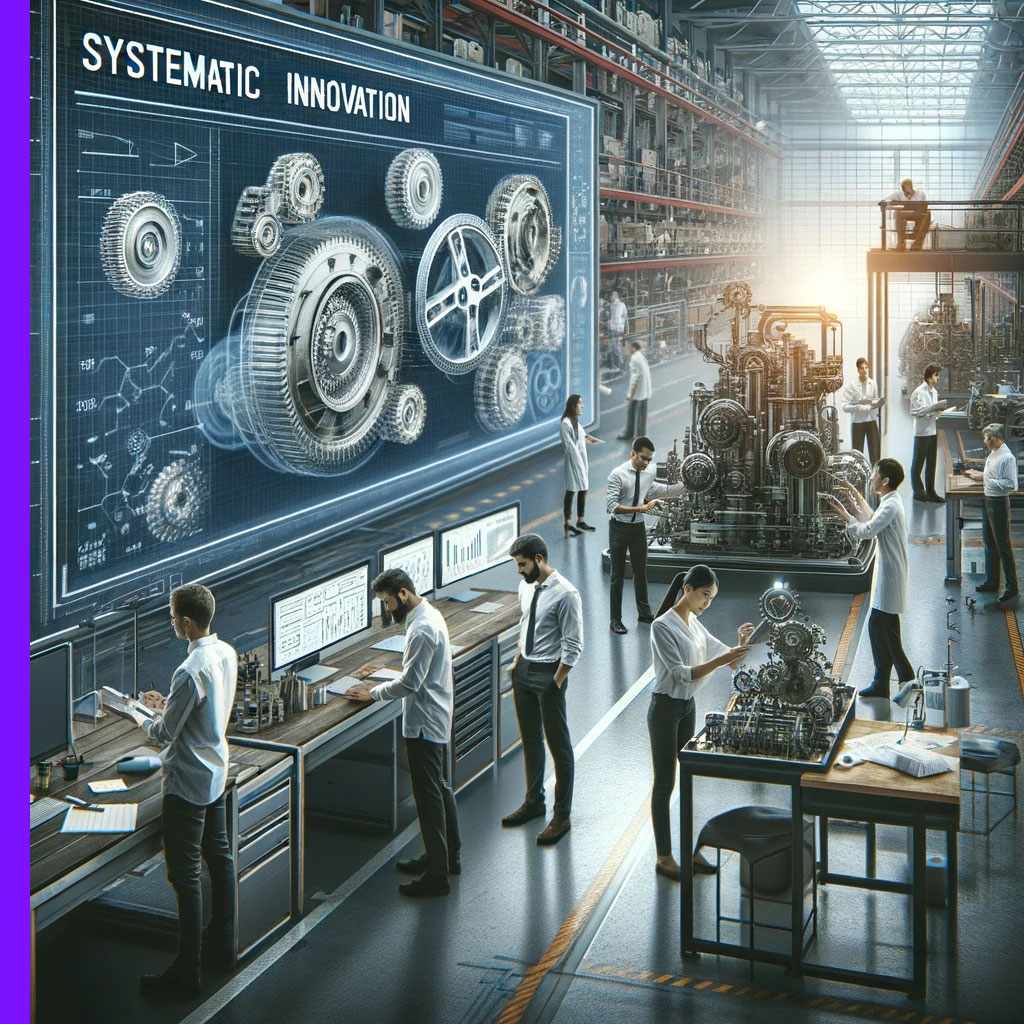
Systematic Innovation
Systematic innovation stands as a structured approach to generating, developing, and implementing innovative solutions. Unlike spontaneous or ad-hoc innovation, systematic innovation relies on defined processes, methodologies, and tools to uncover and exploit opportunities for innovation consistently. This approach aims to make innovation repeatable, scalable, and sustainable within organizations, ensuring that creativity and novel problem-solving are integral, ongoing aspects of business operations. A systematic approach to innovation also eliminates various risks, and yields a far better ROI on innovation processes.
Core Elements of Systematic Innovation
- Structured Processes: Systematic innovation involves clear stages or phases, from idea generation and selection to development and commercialization. Each phase has defined activities, objectives, and outcomes.
- Methodologies and Tools: It employs specific methodologies and tools designed to stimulate creative thinking, solve complex problems, and identify opportunities for innovation. Examples include TRIZ, SIT, Design Thinking, and the Stage-Gate Process.
- Cross-functional Teams: Innovation is fostered through collaboration among teams that bring diverse skills, knowledge, and perspectives. Systematic innovation structures this collaboration to maximize the generation of value-added ideas.
- Innovation Culture: A culture that supports risk-taking, values creativity, and encourages experimentation is essential. Systematic innovation embeds these values into the organizational fabric through policies, incentives, and leadership.
- Continuous Improvement: There is an emphasis on learning and continuous improvement, with feedback loops and mechanisms for capturing lessons learned and applying them to future innovation efforts.
Benefits of Systematic Innovation
- Predictability: By following a structured approach, organizations can make innovation more predictable and manageable, reducing the uncertainty and risk typically associated with innovation.
- Efficiency: Systematic processes help streamline innovation efforts, making better use of resources and potentially reducing the time to market for new ideas.
- Scalability: A systematic approach can be scaled across the organization, ensuring that innovation is not confined to specific departments or innovation labs but is pervasive throughout.
- Quality of Ideas: Employing structured methodologies can improve the quality and feasibility of ideas generated, ensuring that they are aligned with strategic goals and market needs.
Implementing Systematic Innovation
- Define the Innovation Strategy: Establish a clear framework for innovation.
- Fields of Innovation: Will it be in products, services, technology, business models, operations, distribution, HR, or multiple areas, perhaps even all?
- Level of Innovation: Should it be incremental or revolutionary? Will the innovations be new to the company, to the country, or to the world, or a combination thereof?
- Pace of Innovation: Is the goal to launch 1, 10, or 100 new products per year?
- Innovation Targets: What percentage of revenues should come from new products? How many patents should be registered per year? How many new customers should be acquired per month? What is the growth target in new territories?
- Resources for Innovation: Who will be responsible for Innovation Management? What budget and manpower will be dedicated to innovation efforts? Which Think Tanks and forums will be established? Are these resources sufficient to support the defined innovation goals?
- Define the Innovation Process: Establish clear stages for your innovation process, from ideation to implementation, and define the activities and outcomes expected at each stage.
- Select and Train on Methodologies: Choose innovation methodologies and tools that align with your organization's needs and culture. Provide training to employees to ensure they are effectively utilized.
- Foster an Enabling Culture: Cultivate an organizational culture that supports innovation through leadership endorsement, appropriate incentives, and recognition of innovative efforts.
- Encourage Cross-functional Collaboration: Create mechanisms for cross-functional teams to work together on innovation projects, leveraging diverse perspectives for richer, more comprehensive solutions.
- Measure and Adapt: Establish metrics to measure the effectiveness of your innovation efforts. Use these insights to continuously refine and improve your systematic innovation process.
Challenges in Systematic Innovation
- Over-structuring: There's a risk of over-structuring the innovation process, which can stifle creativity and flexibility. Finding the right balance between structure and freedom is crucial.
- Cultural Resistance: Embedding a systematic approach to innovation may face resistance from an organizational culture accustomed to traditional ways of working.
- Keeping Pace with Change: Ensuring that systematic innovation processes remain agile and adaptable in the face of rapid technological and market changes can be challenging.
How to Overcome these Challenges
- Overcoming Over-structuring in Systematic Innovation
- Foster a Flexible Framework: Establish an innovation process that allows for flexibility and spontaneous creativity within a structured approach.
- Encourage Experimentation: Allocate time and resources for free exploration, where employees can work on projects outside the structured innovation process.
- Regularly Review Processes: Periodically assess the innovation process to ensure it remains conducive to creativity and not overly restrictive.
- Tackling Cultural Resistance to Systematic Innovation
- Leadership Endorsement: Secure top management support to champion systematic innovation and its value.
- Incremental Implementation: Gradually introduce systematic innovation practices to allow time for cultural adaptation.
- Celebrate Successes: Highlight and celebrate early wins from the systematic innovation approach to build momentum and buy-in.
- Provide Training and Resources: Equip employees with the knowledge and tools they need to engage with the new system comfortably.
- Keeping Pace with Change through Systematic Innovation
- Embed Agility: Integrate agile methodologies into the innovation process to enhance responsiveness to change.
- Continuous Learning: Foster a culture of continuous learning to keep abreast of technological and market trends.
- External Collaboration: Partner with external entities, such as startups or research institutions, to gain fresh insights and stay ahead of industry shifts.
- Feedback Loops: Establish mechanisms for regular feedback from customers and frontline employees to quickly adapt innovations to changing needs.
In conclusion, Systematic Innovation provides a framework for making innovation a repeatable, sustainable aspect of business operations. By employing structured processes, methodologies, and fostering a supportive culture, organizations can enhance their innovation capabilities, leading to sustained competitive advantage and growth.
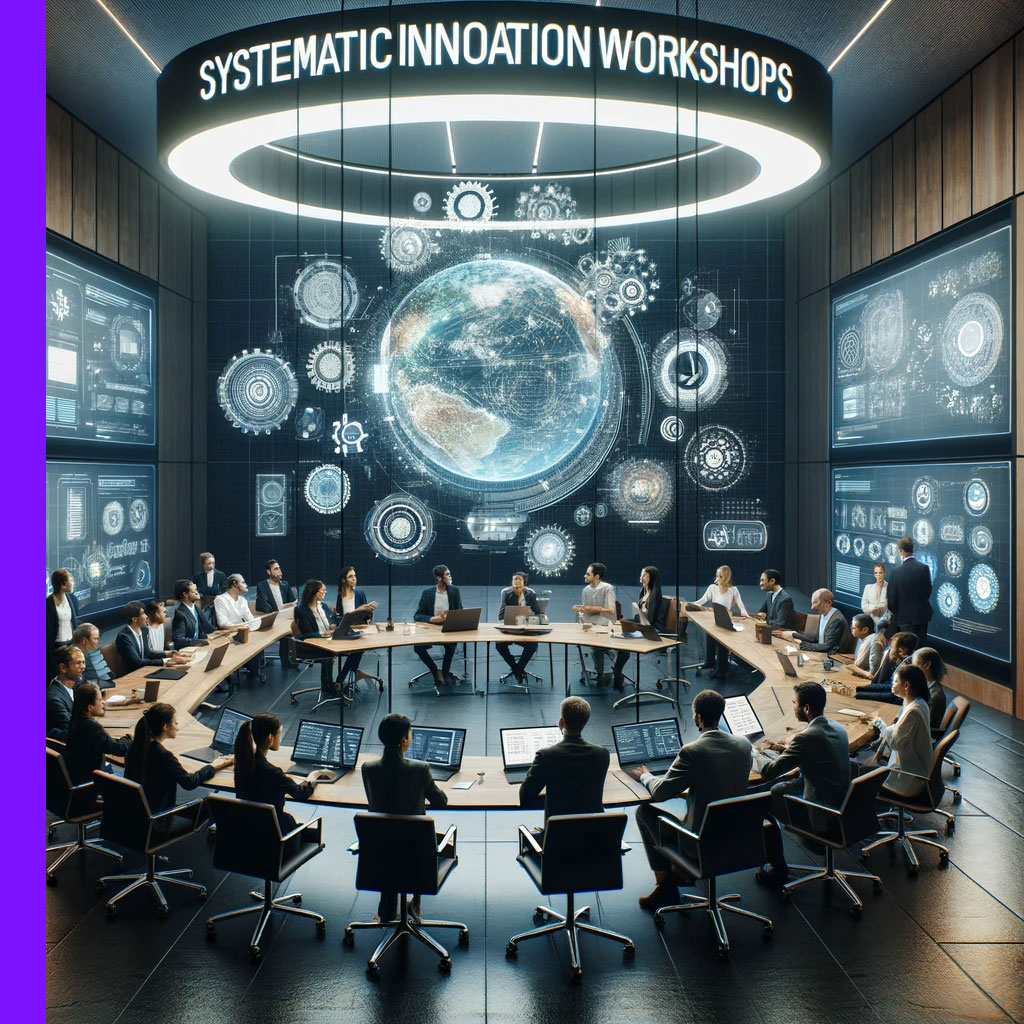
Systematic Innovation™ Workshops
Systematic Innovation™ workshops are designed to equip organizations with the processes and tools needed to manage innovation effectively across all innovation types (strategic innovation, organizational innovation, product and service innovation, and technological innovation) and across all innovation process stages (e.g., defining problems, idea generation, screening, prototyping, testing, commercializing, and promoting).
The Systematic Innovation™ methodology was developed by us (ZOOZ consultancy), following over 25 years of experience in leading innovation workshops with hundreds of organizations from various industries and countries. In essence, this methodology incorporates systematic and highly effective practices, thinking tools and management processes for all innovation aspects.
Our approach to helping organizations excel in innovation is simple: we work with organizations in-house, with internal and dedicated teams, on real cases, by selecting the proper thinking tools for each task and then applying selected systematic methods every step of the way. The framework is usually several days of highly practical workshops, and each tool is demonstrated then applied to organizations’ actual products, services, processes, technologies, problems, and/or strategies. For example, we use Systematic Inventive Thinking, De Bono's Six Thinking Hats, internal screening and concept testing combined, to generate, develop and screen a comprehensive and prioritized idea bank for product or service innovation, within a few days.
By focusing on practical outcomes, such as generating dozens of actionable ideas for new products and services, these workshops have a proven track record of leading to successful products and significant profits in a matter of months. Success stories span various industries, demonstrating the versatility and effectiveness of the methodologies taught.
Systematic Innovation™ Workshop Details
- Practical Focus: Using a major product or service as a starting point, workshops are grounded in real-world applications, ensuring relevance and immediate applicability. The resulting success stories, in turn, encourage the participants to keep using the tools and methods they learned.
- Careful tool selection: Matching the proper tools to the actual needs enhances results. For example, for idea generation, we use (or refrain from) the following:
- Brainstorming – a method that “feels” nice but brings poor results: usually, brainstorming can only predict up to 10% of all valid ideas for future innovation. Therefore, we NEVER use it!
- SCAMPER – seven thinking tools that can be taught in minutes and can predict 30% of all possible ideas for future innovation. We use it for short sessions (1-4 hours) with dozens of participants.
- Systematic Inventive Thinking (SIT) – six thinking tools that require hours to learn and apply but can predict 80% of future innovation - for longer sessions (1-3 days) with a think-tank of 8-12 members.
- TRIZ – a complex methodology with more than 100 tools (that take years to master). We prefer to offer external consulting by TRIZ experts to crack complicated issues organizations may face.
- Cross-Departmental Participation: Selecting the optimal Think Tank, with all relevant expertise. For example:
- For Strategic Innovation – The company management team, as well as board members if applicable (same people that will apply and supervise the updated strategy).
- For Product Innovation – Mainly marketing/product people (to represent the voice of the customer), with a few operations and/or R&D people (to confirm feasibility of ideas).
- For Technological Innovation – Engineers from several departments, which enables benchmarking and idea sharing across departments.
- Global Availability: Tailored to meet the needs of diverse industries worldwide, these workshops are adaptable and can be conducted globally, emphasizing the universal applicability of systematic innovation principles.
For further details, and for ordering Systematic Innovation™ Workshops for your organization, see here.
In summary, Systematic Innovation™ workshops offer a proven, practical framework for fostering innovation within organizations. By focusing on real-world applications and cross-functional collaboration, these workshops not only enhance the innovation process but also drive tangible business results, demonstrating their effectiveness across a wide range of industries and global markets.

Idea Generation
Idea generation is the creative process of generating new and innovative ideas to solve problems, meet market needs, or leverage new opportunities. It's the foundational stage in the innovation process, where quantity often trumps quality, but the recommended goal is, nevertheless, to explore feasible possibilities, and to focus on these opportunities, in order to have a more practical process. Effective idea generation requires a supportive environment that encourages free thinking and values contributions from diverse perspectives, but the eyes should still be on the target (ROI, growth, success stories).
Strategies for Effective Idea Generation
- Diverse Teams: Bringing together individuals with different backgrounds, expertise, and ways of thinking can spark creativity and lead to a broader range of ideas. Diversity challenges conventional thinking and fosters innovative solutions.
- Creative Workshops: Workshops like Inventive Thinking sessions, design sprints, or hackathons provide structured environments for collaborative idea generation. These sessions can be enhanced with techniques such as mind mapping or SCAMPER to stimulate creative thinking.
- Open Innovation Platforms: Leveraging open innovation platforms allows organizations to source ideas from external contributors, including customers, partners, or the broader innovation community. This external input can introduce fresh perspectives and novel solutions.
- Idea Management Software: Digital tools and platforms can facilitate the idea generation process, allowing for the collection, organization, and sharing of ideas across the organization. These platforms often include features for collaboration, voting, and initial evaluation.
- Encouraging a Culture of Curiosity: Fostering an organizational culture that encourages curiosity, experimentation, and the questioning of assumptions can significantly enhance idea generation. Employees should feel empowered to explore new areas and challenge the status quo.
Challenges in Idea Generation
- Volume vs. Viability: Generating a high volume of ideas can sometimes overshadow the focus on viability and strategic alignment. Balancing creativity with practicality is crucial.
- Idea Hoarding: In some cases, individuals or teams may hesitate to share ideas due to fear of criticism or theft. Creating a supportive environment that values all contributions is essential for overcoming this barrier.
- Analysis Paralysis: Overanalyzing or immediately critiquing ideas can stifle creativity and limit the range of concepts generated. It's important to defer judgment during the initial stages of idea generation.
Benefits of Effective Idea Generation
- Innovation Pipeline: A robust idea generation process fills the innovation pipeline with a diverse set of concepts, ensuring a continuous flow of potential projects.
- Competitive Advantage: By continuously generating and exploring new ideas, organizations can stay ahead of market trends and emerging customer needs, maintaining a competitive edge.
- Employee Engagement: Involving employees in idea generation can increase engagement, satisfaction, and a sense of ownership over the innovation process.
In conclusion, idea generation is a critical component of the innovation process, providing the raw material for future development and implementation. By adopting diverse strategies and fostering an environment conducive to creative thinking, organizations can enhance their ability to generate valuable, innovative ideas.
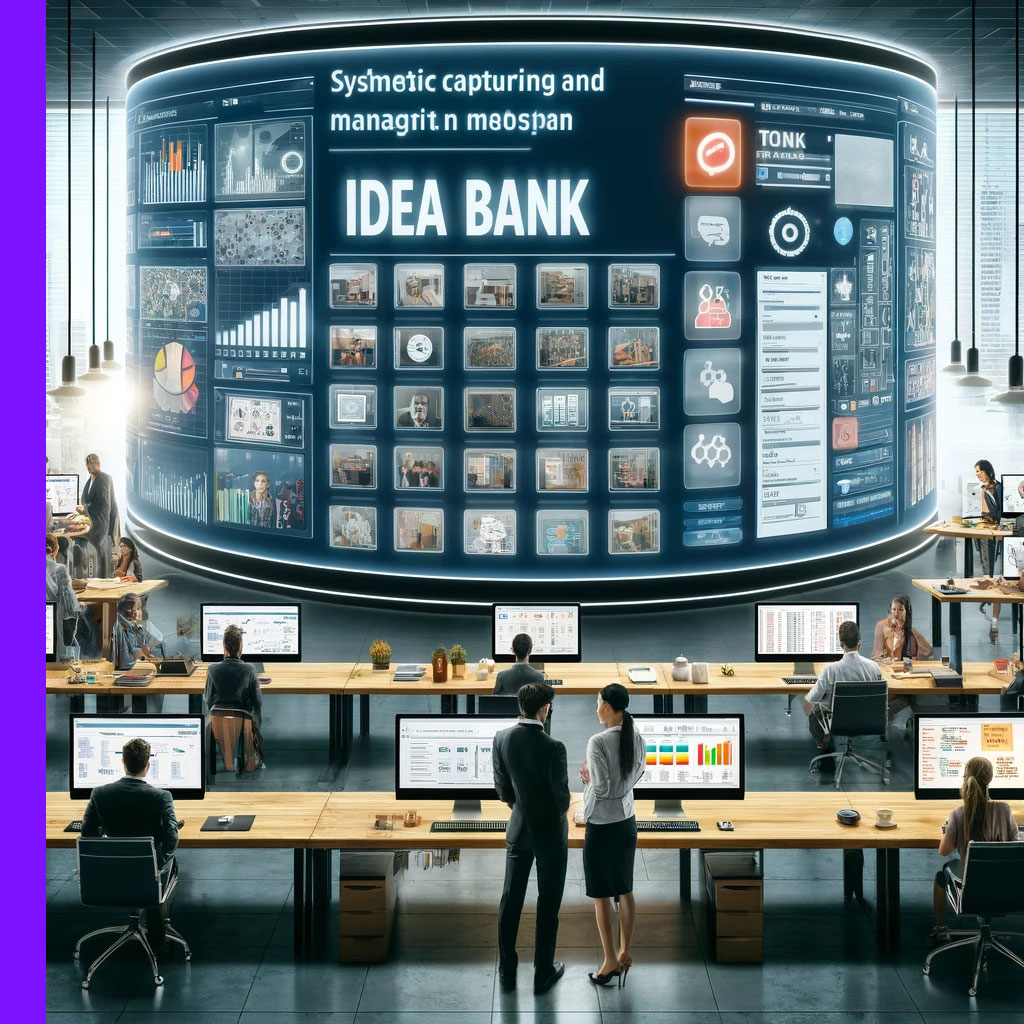
Idea Bank
An Idea Bank is a systematic approach to capturing, storing, and managing the influx of ideas generated within an organization. It acts as a centralized repository where ideas from employees, customers, and other stakeholders can be collected, evaluated, and, if deemed viable, further developed into innovative solutions. The implementation of an Idea Bank is crucial for organizations looking to harness collective creativity and ensure that valuable insights and ideas do not go unnoticed or get lost.
Key Features of an Idea Bank
- Centralization: Provides a single, accessible location where ideas can be submitted by anyone, at any time, ensuring that the process of idea contribution is streamlined and efficient.
- Categorization: Ideas within the bank are categorized based on various criteria such as their focus area (e.g., product, process, service improvement), urgency, or potential impact. This facilitates easier navigation and management of ideas.
- Evaluation Process: Incorporates a structured mechanism for assessing the feasibility, relevance, and potential impact of submitted ideas. This may involve initial screening by a dedicated innovation team and further evaluation by cross-functional stakeholders.
- Feedback Loop: Offers a system for providing feedback to idea contributors, keeping them informed about the status of their submissions and encouraging continuous participation in the innovation process.
- Integration with Innovation Pipeline: Ensures that selected ideas are seamlessly integrated into the organization's broader innovation management process, moving from concept to development and, eventually, to implementation.
Implementing an Idea Bank
- Technology Platform: Utilize a digital platform that supports the submission, storage, and categorization of ideas. Many software solutions offer features like collaboration tools, voting systems, and analytics to enhance the management of the Idea Bank.
- Example: Idea Bank Management in Excel (a simple yet powerful application)
- Promotion and Engagement: Actively promote the Idea Bank within the organization to encourage widespread participation. Engagement strategies might include innovation challenges, rewards for top ideas, and regular updates on the progress and success stories of submitted ideas.
- Example: Gathering Extreme Ideas
- Governance Structure: Establish a clear governance structure for the Idea Bank, including roles and responsibilities for managing the idea evaluation process, providing feedback, and ensuring the progression of selected ideas.
- Continuous Improvement: Regularly review and refine the Idea Bank's processes and platform based on user feedback and evolving organizational needs. This might involve updating evaluation criteria, improving user interfaces, or integrating additional tools for idea development.
Benefits of an Idea Bank
- Efficient Idea Management: Streamlines the process of collecting, evaluating, and selecting ideas for development, ensuring that resources are focused on the most promising initiatives.
- Enhanced Innovation Culture: Demonstrates the organization's commitment to innovation and encourages a culture where employees feel valued for their contributions.
- Diverse Source of Ideas: Captures a wide range of ideas from different parts of the organization and beyond, enriching the innovation pipeline with diverse perspectives.
- Increased Engagement: Engages the broader organization in the innovation process, fostering a sense of ownership and participation among employees and other stakeholders.
In conclusion, an Idea Bank is an essential tool for any organization aiming to cultivate a systematic and inclusive approach to innovation. By effectively capturing and managing ideas, organizations can tap into the collective creativity of their workforce and stakeholders, driving forward innovation and ensuring that no valuable idea goes to waste.

Idea Screening
Idea Screening is a pivotal phase in the innovation process, serving as the bridge between the initial generation of ideas and their development into viable projects or products. This stage involves evaluating and filtering the influx of ideas based on predefined criteria to identify those with the greatest potential for success. Effective idea screening ensures that resources are allocated efficiently, focusing on ideas that align with the organization's strategic goals, meet market needs, and have a feasible path to realization.
Key Components of Idea Screening
- Establishment of Criteria: The first step in idea screening is to establish clear, objective criteria against which ideas will be evaluated. These criteria might include strategic alignment, market potential, feasibility, innovation level, and resource requirements.
- Cross-functional Review: Ideas should be reviewed by a cross-functional team that brings diverse perspectives, including market insights, technical feasibility, financial viability, and operational implications. This holistic approach ensures a comprehensive evaluation of each idea.
- Prioritization: Through the screening process, ideas are not only filtered out but also prioritized based on their potential impact and alignment with organizational priorities. This helps in focusing efforts on the most promising opportunities.
- Feedback Mechanism: Providing feedback to idea contributors is crucial, regardless of whether their idea is selected for further development. Feedback encourages continued engagement and contribution to the innovation process.
- Iterative Screening: Idea screening is not a one-off event but an iterative process. As ideas evolve and more information becomes available, they may be re-evaluated against the screening criteria.
Strategies for Effective Idea Screening
- Transparent Process: Ensure that the idea screening process is transparent and well-communicated across the organization. Understanding how decisions are made encourages participation and trust in the innovation process.
- Flexibility: While having established criteria is crucial, maintaining some degree of flexibility allows for the unexpected value of unconventional ideas to be recognized.
- Leverage Technology: Utilize digital platforms and tools to manage the screening process, allowing for efficient collection of feedback, collaboration among reviewers, and tracking of decisions.
- Example: Idea Bank Management in Excel (simple yet powerful application, with buit-in prioritization)
- Encourage Resubmission: Invite contributors to refine and resubmit ideas that were not selected, especially if they show potential but require further development or alignment.
Challenges in Idea Screening
- Subjectivity: Even with clear criteria, the screening process can be subjective. Ensuring a diverse review team can help mitigate personal biases.
- Overlooking Radical Ideas: There's a risk of overlooking radical or disruptive ideas that don't fit neatly within existing frameworks or criteria.
- A method for overcoming this challenge: Dealing with Extreme Ideas
- Resource Constraints: The screening process itself can be resource-intensive, requiring careful management to ensure it doesn't become a bottleneck in the innovation process.
Benefits of Effective Idea Screening
- Focused Innovation Efforts: By filtering out less viable ideas, organizations can concentrate their efforts and resources on developing ideas with the highest potential.
- Faster Time-to-Market: Streamlining the selection of ideas can accelerate the development process, enabling quicker responses to market opportunities.
- Enhanced Strategic Alignment: Idea screening helps ensure that the innovation portfolio aligns with the organization's strategic objectives, enhancing the overall impact of innovation initiatives.
In conclusion, idea screening is a critical step in the innovation management process, enabling organizations to sift through a multitude of ideas to identify those worth pursuing. By implementing a structured, transparent, and iterative screening process, organizations can enhance their innovation efficiency and effectiveness, ensuring that their innovation efforts are both strategic and impactful.

Concept Development and Prototyping
Concept development and prototyping represent crucial steps in transforming selected ideas into tangible innovations. This phase bridges the gap between abstract ideas and market-ready products or services, allowing teams to explore the feasibility, desirability, and viability of their concepts in real-world scenarios. Through concept development, ideas are refined, tested, and iterated upon, while prototyping brings these ideas to life, enabling hands-on exploration and validation.
Concept Development
- Defining the Concept: This involves fleshing out the details of the idea, including its features, benefits, target audience, and unique value proposition. The goal is to create a clear and compelling description of the product or service that addresses specific user needs or market gaps.
- Market and User Research: Conducting thorough research to understand the market landscape, competitor offerings, and potential customer needs and preferences. This research informs the concept development, ensuring the solution is relevant and differentiated.
- Guidelines for creating a concept testing questionnaire
- Guidelines for conducting a concept testing survey, and analyzing the results
- Feasibility Analysis: Assessing the technical, operational, and financial feasibility of the concept. This includes evaluating the required technologies, resources, and potential costs associated with bringing the concept to market.
- Business Model Exploration: Developing an initial business model that outlines how the concept will generate value for the company and its customers. Considerations include pricing strategies, revenue streams, and distribution channels.
Prototyping
- Prototype Creation: Building a physical or digital prototype of the concept that embodies the key features and functionalities. Prototypes can range from low-fidelity models, such as sketches or mock-ups, to high-fidelity versions that closely resemble the final product.
- User Testing: Engaging potential users to test the prototype, gather feedback, and observe interactions. User testing provides invaluable insights into the usability, desirability, and overall user experience of the concept.
- Iterative Refinement: Using feedback from user testing to refine and improve the prototype. This iterative process of testing, learning, and refining continues until the concept meets the desired criteria and user expectations.
- Technical Validation: Ensuring the prototype meets all necessary technical specifications, quality standards, and regulatory requirements. This may involve additional rounds of testing and adjustments to the design or functionality.
Challenges in Concept Development and Prototyping
- Balancing Creativity and Feasibility: Finding the right balance between innovative ideas and practical feasibility can be challenging. Teams must navigate constraints without stifling creativity.
- Resource Allocation: Prototyping and testing require time, skills, and resources. Efficiently managing these resources is crucial to keep the development process on track.
- Note: To save time and costs, apply Lean methodology and use MVPs (minimal viable products)
- User Engagement: Recruiting participants for user testing and ensuring their feedback is representative and actionable can be difficult, especially for niche or innovative products.
Benefits of Concept Development and Prototyping
- Risk Reduction: Early and iterative testing of concepts and prototypes helps identify and mitigate risks before significant investments are made.
- Enhanced User-Centricity: Direct user feedback ensures the final product is closely aligned with user needs and expectations, increasing the likelihood of market success.
- Improved Planning: Through systematic concept testing, calibrated over-time, it's possible to predict demand more accurately for new products or services, facilitating better planning for supply orders, promotional activities, and other operational needs.
- Faster Time-to-Market: An iterative approach to concept development and prototyping can accelerate the innovation process, enabling quicker adjustments and decisions.
- Stakeholders' Engagement: Achieving positive outcomes from concept testing can bolster stakeholder confidence and investment in the invention.
In conclusion, concept development and prototyping are essential for turning innovative ideas into viable products or services. By thoroughly exploring, testing, and refining concepts, organizations can enhance the fit between their innovations and market needs, ultimately increasing the success rate of their new ventures.

Commercialization
Commercialization is the critical final phase in the innovation process where a product or service is introduced to the market. It encompasses a range of activities from production scaling, marketing strategy development, sales channel establishment, to customer support planning. This stage is where the tangible outcomes of the innovation process are realized, and the value created through ideation, development, and prototyping is captured in the marketplace. Successful commercialization requires strategic planning, market understanding, and effective execution to ensure that the new product or service can compete successfully and meet the targeted returns on investment.
Key Steps in Commercialization
- Market Analysis and Strategy Development: Deeply understanding the target market, including customer needs, market size, competition, and trends, is crucial. Based on this understanding, develop a comprehensive market entry strategy that outlines positioning, pricing, distribution, and promotion plans.
- Example: Marketing Penetration (how to effectively reach your target audience)
- Production and Operations Scaling: Prepare for the launch by scaling up production and operations to meet anticipated market demand. This includes ensuring supply chain readiness, quality control measures, and logistical arrangements.
- Marketing and Launch Activities: Implement marketing strategies to build awareness and anticipation for the product. This could involve advertising campaigns, PR activities, launch events, and leveraging social media platforms to reach potential customers.
- Sales Channel Development: Establish and optimize sales channels that will be used to bring the product to customers. This might include online platforms, retail partnerships, direct sales teams, or distribution networks, depending on the product and market strategy.
- Customer Support and Service: Develop a customer support plan to handle inquiries, feedback, and after-sales service. Providing excellent customer support is essential for building brand loyalty and managing the product's reputation in the market.
Challenges in Commercialization
- Market Acceptance: One of the biggest challenges is ensuring that the market accepts and adopts the new product. This requires not only a deep understanding of customer needs but also the ability to effectively communicate the product's value proposition.
- Competition: New products often face stiff competition from existing solutions. Differentiating the product and carving out a market niche are critical for success.
- Resource Allocation: Commercialization can be resource-intensive. Allocating sufficient resources for marketing, sales, and support activities while managing the overall budget can be challenging.
- Regulatory Compliance: Depending on the industry, new products may need to meet specific regulatory requirements before they can be launched. Navigating these regulations can be complex and time-consuming.
Strategies for Successful Commercialization
- Early Customer Engagement: Engage potential customers early in the development process to gather feedback and build a customer base before the official launch.
- Strategic Partnerships: Forming partnerships with other companies can provide valuable resources, expertise, and access to established customer networks.
- Agile Approach: Be prepared to adapt the commercialization strategy based on early market feedback. An agile approach allows for quick adjustments to marketing, pricing, or distribution strategies as needed.
- Measuring Success: Establish clear metrics for measuring the success of the commercialization effort. This includes sales performance, market penetration rates, customer satisfaction scores, and return on investment.
Commercialization is where the innovation journey culminates in market entry and revenue generation. It requires a strategic approach, careful planning, and effective execution across multiple domains. By understanding and navigating the challenges of commercialization, organizations can successfully launch new products and services, achieving sustainable growth and competitive advantage.

Innovation Research
Innovation research is a systematic approach to gathering, analyzing, and interpreting data that informs the innovation process. It encompasses market research, technology trends analysis, competitive intelligence, and user needs assessments, providing a solid foundation for making informed decisions about where and how to innovate. By identifying emerging trends, unmet customer needs, and potential areas for differentiation, innovation research helps organizations to direct their innovation efforts more effectively and reduce the risk associated with developing new products, services, or processes.
Key Aspects of Innovation Research
- Market Trends Analysis: Understanding the broader market trends is crucial for anticipating future demands and identifying areas ripe for innovation. This involves analyzing industry reports, market forecasts, and consumer behavior studies to spot emerging patterns.
- Customer Insights Gathering: Directly engaging with current and potential customers to uncover their needs, preferences, and pain points. Techniques such as surveys, interviews, focus groups, and ethnographic studies can provide deep insights into customer motivations and behaviors.
- Competitive Intelligence: Monitoring competitors’ activities, offerings, and strategies helps in identifying gaps in the market, potential areas for differentiation, and emerging industry standards or technologies that could impact the competitive landscape.
- Technology Scouting: Keeping abreast of technological advancements and breakthroughs that could offer new opportunities for innovation. This includes attending industry conferences, reviewing academic and research publications, and engaging with technology incubators or startups.
- Regulatory and Environmental Scanning: Understanding the regulatory environment and socio-economic factors that could influence the success of new innovations. This includes analyzing legislation, environmental trends, and socio-political developments that could impact market needs or the feasibility of certain innovations.
Strategies for Conducting Effective Innovation Research
- Diverse Sources: Utilize a wide range of sources for gathering information, including primary research, public databases, industry associations, and social media analytics, to get a comprehensive view of the innovation landscape.
- Cross-functional Teams: Involve team members from different functions and departments in the research process to ensure a multidisciplinary perspective on the data collected. This can enhance the analysis and interpretation of research findings.
- Continuous Monitoring: Innovation research should not be a one-time activity but an ongoing process that continuously feeds into the innovation strategy. Regularly updating research findings helps organizations stay ahead of market changes and technological developments.
- Leveraging Data Analytics: Employ advanced data analytics and business intelligence tools to analyze large datasets, uncover patterns, and generate actionable insights that can guide innovation efforts.
Challenges in Innovation Research
- Data Overload: The vast amount of available data can be overwhelming. Filtering and focusing on the most relevant and reliable information are crucial for effective analysis.
- Rapid Change: In fast-moving industries, keeping research up-to-date can be challenging, as new technologies and market dynamics can quickly render previous findings obsolete.
- Translating Insights into Action: Turning research insights into actionable innovation initiatives requires not only analytical skills but also creativity and strategic thinking.
Innovation research plays a vital role in the innovation process, offering the insights needed to make informed decisions about where to focus innovation efforts. By systematically gathering and analyzing relevant data, organizations can identify opportunities for innovation that are aligned with market needs, technological trends, and competitive dynamics, thereby enhancing their chances of success in bringing new and impactful innovations to market.
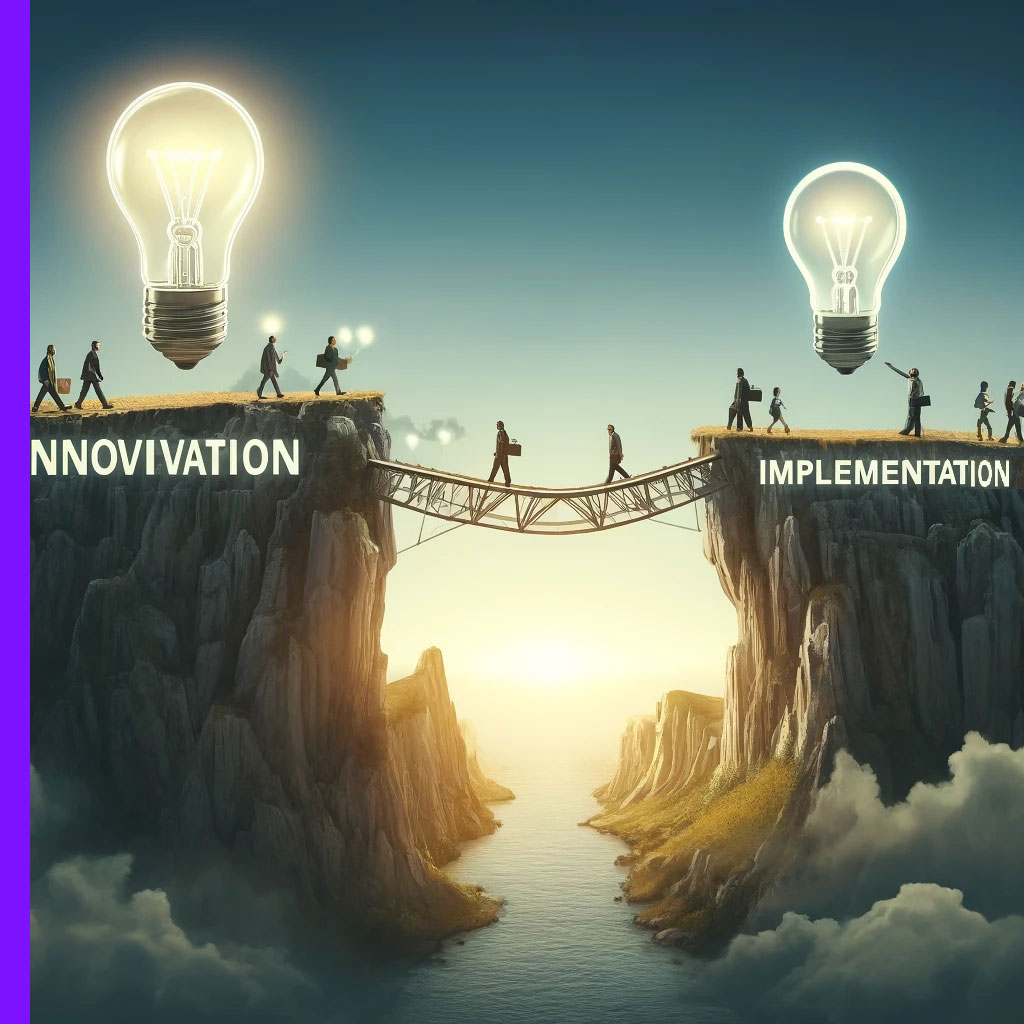
Innovation to Implementation
Transitioning from innovation to implementation is a critical phase in the innovation process, where conceptual ideas and prototypes are transformed into fully realized products, services, or processes that deliver real value to users and stakeholders. This phase encompasses a series of strategic, operational, and managerial activities aimed at bringing innovations to market successfully and at scale. It requires careful planning, coordination, and execution across various departments and teams within an organization.
Key Steps in Innovation to Implementation
- Finalizing the Design: Based on feedback from prototyping and testing phases, finalize the design and specifications of the product or service. Ensure it meets all user requirements, technical standards, and regulatory compliance needs.
- Developing a Launch Plan: Create a comprehensive plan for launching the innovation, including marketing strategies, distribution channels, pricing models, and sales targets. The plan should also outline any necessary support structures, such as customer service and maintenance.
- Scaling Production: For physical products, this involves setting up or expanding manufacturing capabilities to produce innovation at scale. For services or digital products, ensure the infrastructure and systems are in place to support delivery at scale.
- Building Internal Capabilities: Equip your team with the necessary skills and knowledge to support innovation. This may involve training sessions, hiring new talent, or forming partnerships to fill capability gaps.
- Market Introduction: Execute the launch plan, introducing the innovation to the market through selected channels. Monitor the launch closely to address any issues promptly and to gather early feedback from users.
- Iterative Improvement: Use feedback from early adopters to make iterative improvements to the product or service. Continuous improvement post-launch is crucial for maintaining relevance and competitiveness.
Challenges in Moving from Innovation to Implementation
- Resource Allocation: Securing the necessary resources, including funding, personnel, and materials, can be challenging, especially for large-scale or high-risk projects.
- Cross-functional Coordination: Effective implementation requires seamless coordination across different functions, from R&D and marketing to sales and customer support, which can be complex to manage.
- Market Acceptance: Ensuring the market accepts and adopts innovation is a significant challenge. It requires effective marketing, education, and sometimes a shift in consumer behavior or perception.
- Scaling Challenges: Scaling production and delivery while maintaining quality and consistency can be difficult, particularly for startups or smaller organizations.
Strategies for Successful Implementation
- Early and Continuous Stakeholder Engagement: Engage with all stakeholders, including customers, employees, and partners, early and throughout the implementation process to ensure alignment and buy-in.
- Agile Project Management: Adopt agile methodologies to manage the implementation process, allowing for flexibility and rapid adjustments based on feedback and changing conditions.
- Risk Management: Identify potential risks early in the process and develop mitigation strategies to address them proactively.
- Performance Monitoring: Establish clear metrics to monitor the performance of the innovation post-launch. Use these metrics to guide decision-making and continuous improvement efforts.
Transitioning from innovation to implementation is where ideas prove their value by becoming tangible solutions that meet user needs and achieve business objectives. Despite the challenges, with careful planning, effective coordination, and a focus on continuous improvement, organizations can successfully bring their innovations to market and realize their potential impact.

Innovation Alliance
An Innovation Alliance refers to a strategic partnership between two or more organizations that collaborate on research and development, share knowledge, or co-create products and services to drive innovation. These alliances can include partnerships between businesses, academic institutions, research organizations, and even competitors, with the goal of pooling resources, expertise, and capabilities to accelerate the innovation process and achieve mutual benefits that would be challenging to attain independently.
Key Aspects of Innovation Alliances
- Shared Goals and Objectives: Establishing clear, shared goals and objectives is crucial for the success of an innovation alliance. Partners must align on the vision, outcomes, and metrics for success to ensure collaborative efforts are focused and effective.
- Complementary Strengths: Successful innovation alliances often bring together partners with complementary strengths, such as a startup’s agility and innovative approach paired with a larger corporation’s resources and market reach. This synergy can create a competitive advantage and drive more impactful innovations.
- Governance and Structure: Defining the governance structure and operational model of the alliance is essential for managing the partnership. This includes agreements on intellectual property rights, revenue sharing, and decision-making processes.
- Open Communication and Trust: Open communication and trust are foundational to any successful alliance. Partners must be willing to share knowledge, insights, and feedback openly and constructively to foster a win-win collaborative environment.
- Flexibility and Adaptability: The ability to adapt to changing circumstances, market conditions, and project needs is vital. Innovation alliances should be flexible enough to pivot their strategies or focus areas as required.
Challenges in Forming and Managing Innovation Alliances
- Aligning Interests: Ensuring all partners have aligned interests and are equally committed to the alliance’s success can be challenging, especially when objectives evolve over time.
- Managing Intellectual Property: Navigating intellectual property ownership and rights can be complex, requiring clear agreements to protect the interests of all parties involved.
- Cultural Differences: Overcoming cultural differences and integrating diverse organizational cultures and working styles can pose significant challenges.
Strategies for Successful Innovation Alliances
- Careful Partner Selection: Choose partners based on strategic fit, complementary capabilities, and cultural alignment. Due diligence in partner selection can prevent conflicts later on.
- Clear Legal Frameworks: Develop comprehensive agreements that cover all aspects of the alliance, including contributions, governance, IP rights, and exit strategies.
- Joint Innovation Teams: Establish dedicated teams with representatives from all partners to work on the alliance’s projects. This fosters a sense of unity and collaboration.
- Regular Review and Adjustment: Conduct regular reviews of the alliance’s progress, goals, and strategies. Be prepared to make adjustments to ensure the partnership remains aligned with the original objectives and continues to deliver value.
Innovation alliances offer a powerful mechanism for organizations to leverage external expertise and resources, mitigate risks, and accelerate the development and commercialization of new innovations. By carefully selecting partners, establishing clear frameworks for collaboration, and fostering a culture of openness and trust, organizations can overcome the challenges of innovation alliances and achieve greater success together.
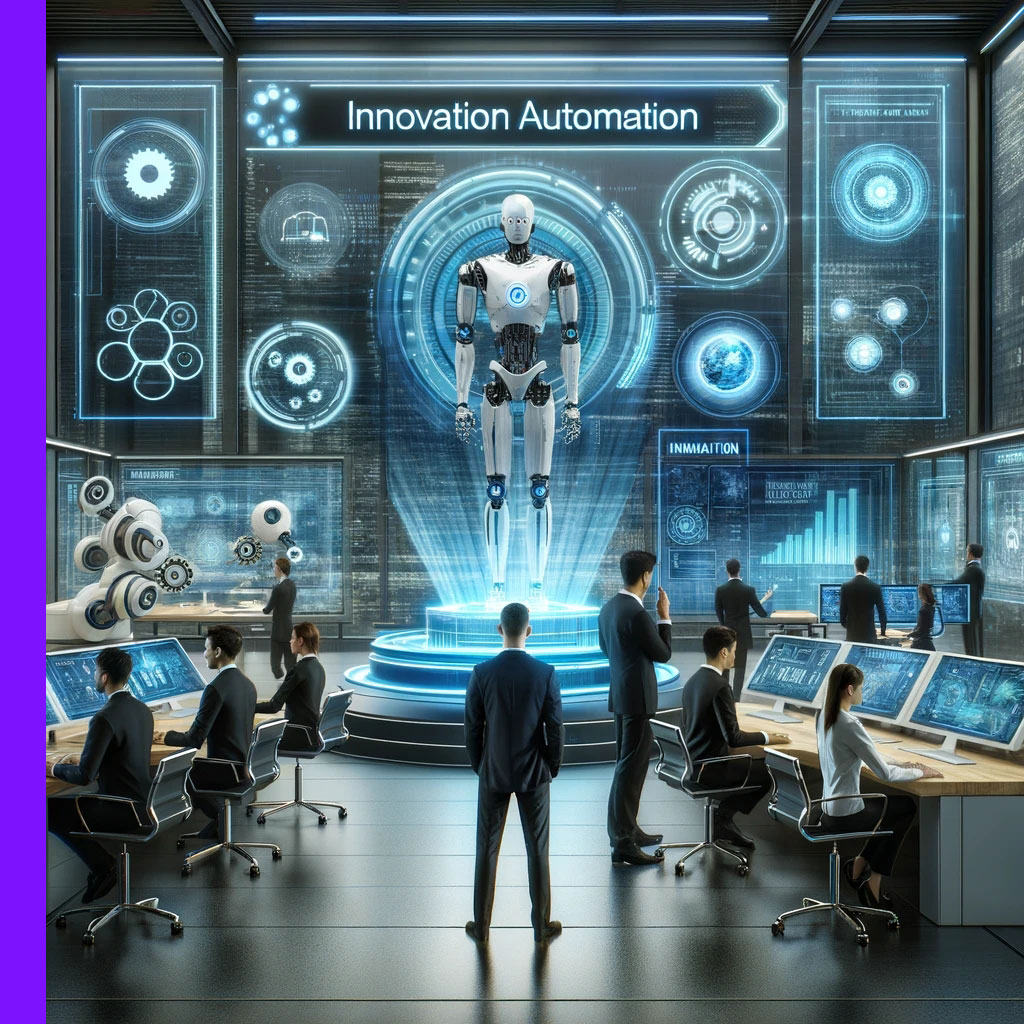
Innovation Automation
Innovation automation involves leveraging technology to streamline and enhance the innovation process, from idea generation to implementation. By automating repetitive tasks, gathering and analyzing data more efficiently, and facilitating seamless collaboration, technology can significantly accelerate the pace of innovation while reducing costs and human error. This approach not only optimizes the innovation process but also frees up valuable human resources to focus on more creative and strategic activities, thereby fostering a more dynamic and productive innovation ecosystem.
Key Components of Innovation Automation
- Idea Management Systems: Digital platforms, Brightidea, Spigit, and IdeaScale, automate the collection, sorting, and tracking of ideas from various sources. These systems enable organizations to manage their idea pipelines more effectively, ensuring that valuable insights are not lost and that promising ideas are promptly acted upon.
- Data Analytics and AI: Advanced analytics and artificial intelligence tools, such as IBM Watson, Google Analytics, and TensorFlow, can automate the analysis of large datasets to identify trends, patterns, and insights that inform the innovation process. AI algorithms can also predict market movements, customer behavior, and the potential success of new innovations.
- Collaboration Tools: Automation tools, like Slack, Microsoft Teams, and Zoom, facilitate seamless collaboration across teams and departments, regardless of geographical location. These tools can automate the sharing of information, project updates, and feedback, ensuring that all stakeholders are aligned and engaged.
- Project Management Software: Automated project management solutions, such as Asana, Trello, and Monday.com, help streamline the planning, execution, and monitoring of innovation projects. These tools can automate scheduling, resource allocation, and progress tracking, ensuring projects stay on track and within budget.
- Prototyping Tools: Digital prototyping tools, like Autodesk Fusion 360, Adobe XD, and Sketch, automate the creation of product models, allowing for rapid iteration and testing. This accelerates the development process and enables more extensive experimentation and refinement.
Benefits of Innovation Automation
- Increased Efficiency: By automating routine tasks, organizations can significantly reduce the time and resources required to manage the innovation process, allowing for more rapid development cycles.
- Enhanced Creativity: Automation frees employees from repetitive tasks, giving them more time to focus on creative problem-solving and strategic thinking.
- Data-Driven Decisions: Automated data analysis provides a solid foundation for making informed decisions about where to focus innovation efforts, reducing the risks associated with new ventures.
- Scalability: Automation tools can easily scale to support the management of a growing number of innovation projects, facilitating sustainable growth in an organization’s innovation capacity.
Challenges in Implementing Innovation Automation
- Integration with Existing Systems: Integrating new automation tools with existing systems and processes can be complex and may require significant adjustments.
- Human Resistance: Employees may resist the introduction of automation tools due to fears of job displacement or changes in their work routines.
- Maintaining Creativity: Ensuring that automation supports rather than stifles creativity is crucial. Organizations must strike the right balance between automated efficiency and creative freedom.
Strategies for Successful Innovation Automation
- Strategic Implementation: Carefully plan the implementation of automation tools, ensuring they align with the organization’s innovation goals and complement existing processes.
- Training and Support: Provide comprehensive training and ongoing support to help employees adapt to new tools and understand their benefits.
- Continuous Evaluation: Regularly assess the impact of automation on the innovation process and make adjustments as needed to optimize performance and outcomes.
Innovation automation represents a powerful lever for enhancing the efficiency, effectiveness, and scale of innovation activities. By thoughtfully integrating automation tools into the innovation process, organizations can accelerate their innovation cycles, make more informed decisions, and foster a more vibrant and productive innovation ecosystem.

Open Innovation
Open innovation is a paradigm that asserts organizations can and should use external ideas as well as internal ideas, and internal and external paths to market, as they look to advance their technology. It contrasts with the traditional closed innovation model that restricts innovation processes to the internal boundaries of an organization. Open innovation leverages the collective brainpower of external contributors, such as customers, researchers, startups, and even competitors, to drive innovation more efficiently and effectively.
Key Aspects of Open Innovation
- Inbound Open Innovation: This involves bringing external ideas and technologies into the organization to enhance its innovation projects. It can include partnerships with academic institutions, crowdsourcing, licensing technologies, or acquiring startups.
- Outbound Open Innovation: In this model, unused or underutilized internal ideas and technologies are taken outside the organization through spin-offs, licensing, or joint ventures, creating new revenue streams and opportunities for growth.
- Collaborative Open Innovation: This approach combines inbound and outbound strategies to collaborate with external partners on joint development projects, sharing risks, costs, and rewards.
Benefits of Open Innovation
- Increased Creativity and Diversity: Incorporating a wide range of external perspectives can lead to more creative solutions and a greater diversity of ideas.
- Accelerated Time to Market: Access to external ideas and technologies can significantly speed up the innovation process, from ideation to commercialization.
- Cost Efficiency: Sharing development costs and risks with external partners can make innovation projects more financially viable.
- Access to New Markets: Collaborating with partners in different regions or sectors can provide valuable insights and access to new markets.
Challenges in Implementing Open Innovation
- Intellectual Property Management: Navigating intellectual property rights and ensuring fair agreements can be complex and requires careful management.
- Cultural and Organizational Barriers: Adopting an open innovation model may require significant cultural shifts within an organization, particularly in moving away from the 'not invented here' syndrome.
- Quality Control: Ensuring the quality and feasibility of external ideas and maintaining the organization’s standards can be challenging.
Strategies for Successful Open Innovation
- Establish Clear Frameworks: Develop clear guidelines and frameworks for managing partnerships, intellectual property rights, and project governance.
- Foster a Culture of Collaboration: Encourage a culture that values external collaboration and open exchange of ideas, supported by leadership endorsement.
- Leverage Digital Platforms: Utilize digital platforms and tools, like InnoCentive and Kaggle, to facilitate collaboration, idea management, and integration of external innovations.
- Build Strategic Partnerships: Carefully select and cultivate partnerships with external organizations that share similar goals and values.
Open innovation represents a strategic shift in how organizations approach research and development, breaking down the barriers to innovation and leveraging the global community to drive progress. By embracing open innovation, companies can enhance their innovation capabilities, tap into new sources of ideas and technologies, and stay competitive in rapidly changing markets.
Systematic innovation
Interested in getting help with systematic innovation processes and developing new products and services?
Contact us: [email protected] ,+972-9-958-5085
Innovation Articles
- Innovation - overview
- Innovation management and process
- Innovation tools and methods
- Innovation and other disciplines
- Innovation in organizations
- Innovation importance and goals
- Innovation values and inspiration
- Innovation education and career
- Product and service innovation
- Technological innovation
- Innovation examples
- Innovation terms (glossary)





